Consumers are increasingly gravitating toward brands and retailers that make them feel seen and heard through hyper-personalized, contextualized shopping journeys. Retailers acknowledge the importance of delivering unique experiences and an overwhelming majority of digital marketers agree that the failure to overcome personalization challenges carries a high cost.
Online and offline merchandising is all about creating immersive and personalized shopping journeys to display and sell the right products to customers. It encompasses everything from the atmosphere of your online store to on-site search, navigation, detailed product tags, filters, and product recommendations. The more engaged shoppers are with exploring your products and visiting multiple pages, the more likely they are to spend.
But many brands fall short in this regard, with an average eCommerce bounce rate of 43% as of last year. Merchandising automation is a solution that addresses this concern by streamlining the entire process of merchandising so brands can deliver shopping experiences that click with customers while also saving time and resources.
AI and automation empower companies to boost their performance, and Gartner predicts that those who fail to implement AI in their merchandising strategies to achieve shopper-oriented experiences will not survive the pressure of new consumer expectations, economic constraints, and business requirements.
Merchandising automation covers many bases, including AI tagging and recommendation carousels to curated product collections and analyzing real-time user behavior. When set up and implemented effectively, merchandising automation improves inventory management for retailers on the backend, maximizes valuable eCommerce real estate, and helps brands and retailers increase their bottom line.
How Merchandising Automation Works
The foundation of effective merchandising lies in AI-enriched automatic product tagging. Powered by visual AI, it breaks down each element within a product image, categorizes it, and tags it with additional metadata. This bypasses the need of labor-intensive manual product tagging, which involves the data entry of thousands to millions of products input one by one by a dedicated team.
Automated merchandising ensures tagging can be done at scale and consistently across massive inventories. It takes out the need for the manual and time-consuming curation of products appearing in recommendation engines, search results, and collections and how they’re ranked or prioritized.
It’s much easier and faster to configure merchandising rules based on automated tags according to business goals and prioritize items, collections, banners, and promotions that will spark interest and lead customers toward the path to purchase.
For example, you may select SKUs with a specific color or of a certain style or price via their tags, and then create a collection for a promotion or display them as featured items on your homepage to inspire shoppers arriving to your site.
Merchandising rules can also be used in recommendation carousels to promote overstock items on relevant product listing pages and product detail pages and, in turn, draw customers’ attention and drive conversion.
The Power of Merchandising Automation
1. Fosters Improved Productivity and Efficiency
Product tagging is a time-consuming and manual process typically led by merchandising teams. With merchandising automation, product tags are generated automatically using visual AI, which prevents the possibility of human errors and inconsistencies and frees up employees to focus on other projects.
For fashion businesses, McKinsey found that integrated digital solutions like smart merchandising make it up to 50% faster to bring products to market and lead to an 8% rise in full-price sell-through. Automation also allows brands to scale their operations while minimizing costs and results in a 20% decline in manufacturing costs for fashion retailers.
2. Connects Customers to the Perfect Products
If you have a vast catalogue, make sure your customers can find what they’re looking for as quickly and easily as possible. With automated product tags, every item in a retailer’s catalogue is accurately tagged using a rich lexicon of attributes.
This means when a new or existing customer looks for an item on an eCommerce site through the search bar or image search, they are met with relevant results. Once they click over to the product detail page, they’re met with even more personalized items through recommendation carousels powered by automated merchandising behind-the-scenes.
3. Encourages Customer Loyalty
Customers like it when brands and retailers make them feel special, and eCommerce sites can achieve this through personalized on-site merchandising. At least 71% of customers say they expect companies to deliver personalized interactions, and 78% state they’re more likely to repurchase from brands that provide personalization.
Following an exceptional shopping journey, customers often pay it forward by advocating for your brand to family, friends, and online contacts. About 94% of U.S. customers will recommend companies that have very good services.
4. Promotes Omnichannel Readiness
Many shoppers begin their path to purchase on one channel and finalize their transaction on another. 67% say they use multiple touchpoints before purchasing, and a majority of shoppers dislike fragmented experiences. Seventy-eight percent say they expect consistency in every channel.
For instance, when shoppers look for a retro two-tone TV stand on a home decor brand’s online site and immediately get accurate search results, they also count on real-life shop assistants to have similar ease in locating the product they want.
With merchandising automation, brands and retailers can synchronize data across channels. This ensures product visibility so customers can discover and purchase products where they prefer and also promotes frictionless shopping journeys.
Home Decor Product Tagging and Merchandising Automation Use Cases
Visual Search
When retailers return unsatisfactory and irrelevant search results for customers, 85% of shoppers begin to view a brand differently, and almost half leave the site to purchase the product elsewhere. However, a good search translates to shoppers adding more items to their carts and returning for future purchases.
To make finding products online comparable to browsing in-store, City Furniture’s search bar offers up a camera icon with a photo search prompt, encouraging visitors to upload their photos.
After adding a picture from the homepage search bar, the web page is automatically populated with similar items that customers can open in new tabs and inspect closely. Behind the scenes, visual AI works to surface the most visually similar items and is part and parcel of a retailer’s merchandising strategy.
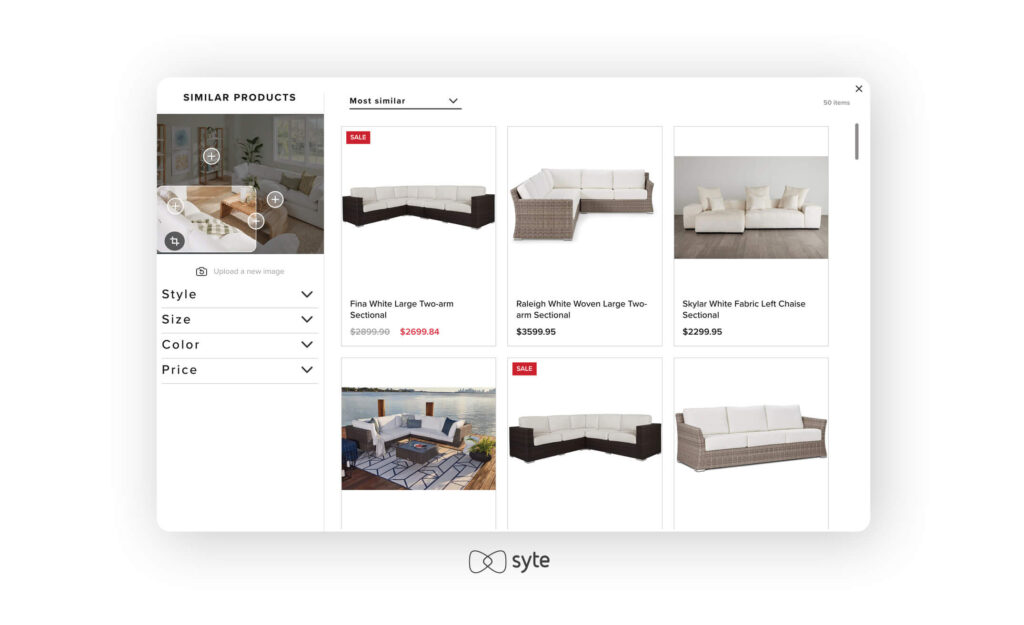
Recommendation Carousels
To keep customers engaged, brands can leverage recommendation engines powered by home decor AI to surface visually similar items and complementary products. When these engines display products based on customer intent and context, they can prevent shoppers from abandoning their carts and encourage them to continue browsing.
The feature is flexible and can be added almost anywhere on your website, including your homepage, product detail pages, and checkout screen. You can see product recommendations in action on dedicated pages for McGee & Co.’s products.
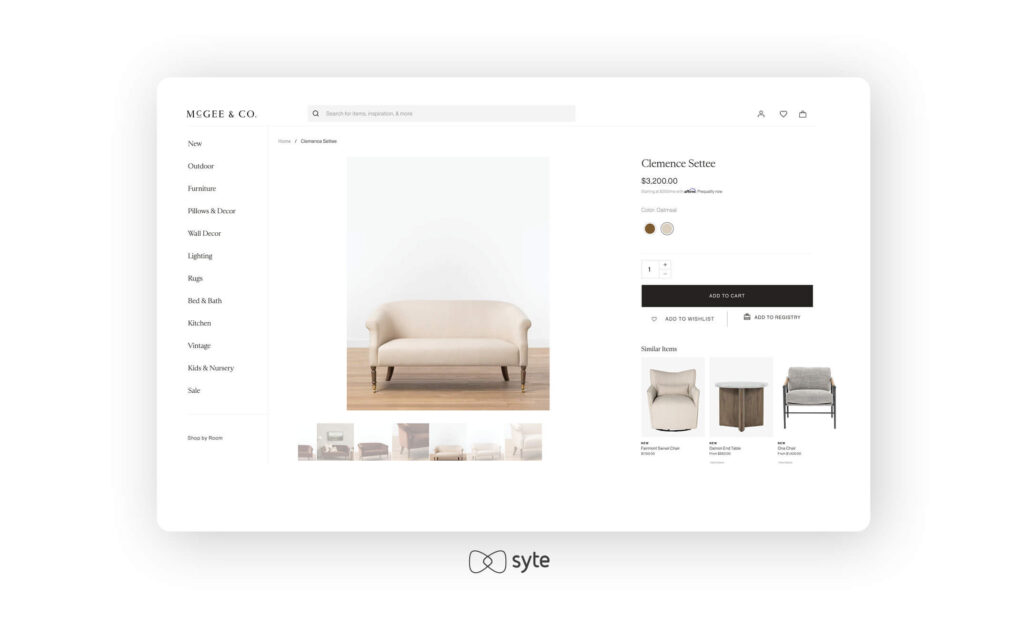
Product recommendations improve both brand perception and the customer experience. By showcasing merchandise that appeals to shoppers’ unique preferences, retailers communicate that they can be trusted to know what buyers want and need. In fact, 37% of customers that interact with a recommendation during their first visit to an eCommerce site come back to shop.
Upselling and Cross-Selling Items
Even after a customer has made a purchase, there are still plenty of opportunities for retailers to maximize their profits. According to Hubspot, 72% of salespeople who upsell and 74% who cross-sell report that these strategies can drive up to 30% of their revenue.
By using merchandising automation and home decor tagging, retailers can help customers find products they may have yet to consider through upselling and cross-selling, which enhances the overall shopping experience and increases customer satisfaction. For example, on Etoffe’s shopping cart page, the retailer suggests care products for their fabrics and wallpapers to maintain their quality and beauty for years to come.
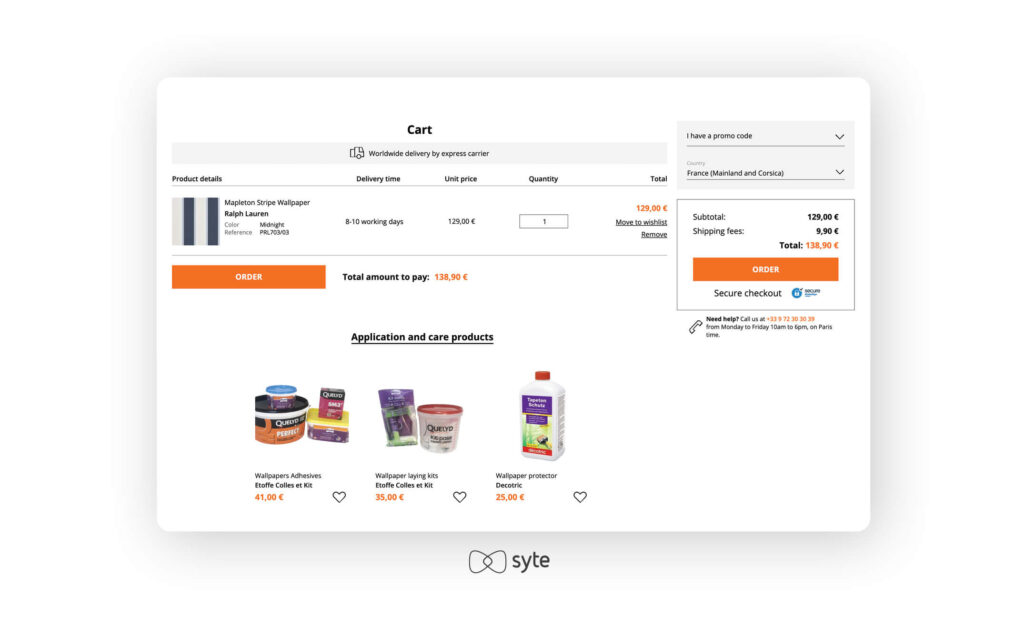
Jewelry Product Tagging and Merchandising Automation Use Cases
Site Navigation
The future of online jewelry shopping hinges upon making the journey to the right products as smooth and effortless as possible. If you do it right and begin with something as basic as navigation, you can encourage and inspire shoppers and ultimately increase the likelihood of a purchase.
Consumers are easily turned off by navigation challenges. About 31% of websites have subpar navigation, featuring categories that are either too broad or too specific. If your website is difficult to figure out, shoppers are likely to seek another retailer that offers a more user-friendly experience.
Rare Carat takes the guesswork out of choosing diamonds by navigating shoppers through the shape, color, clarity, cut, and price of a diamond all on one screen. It then takes customers to the next step of choosing a setting and completing the ring.
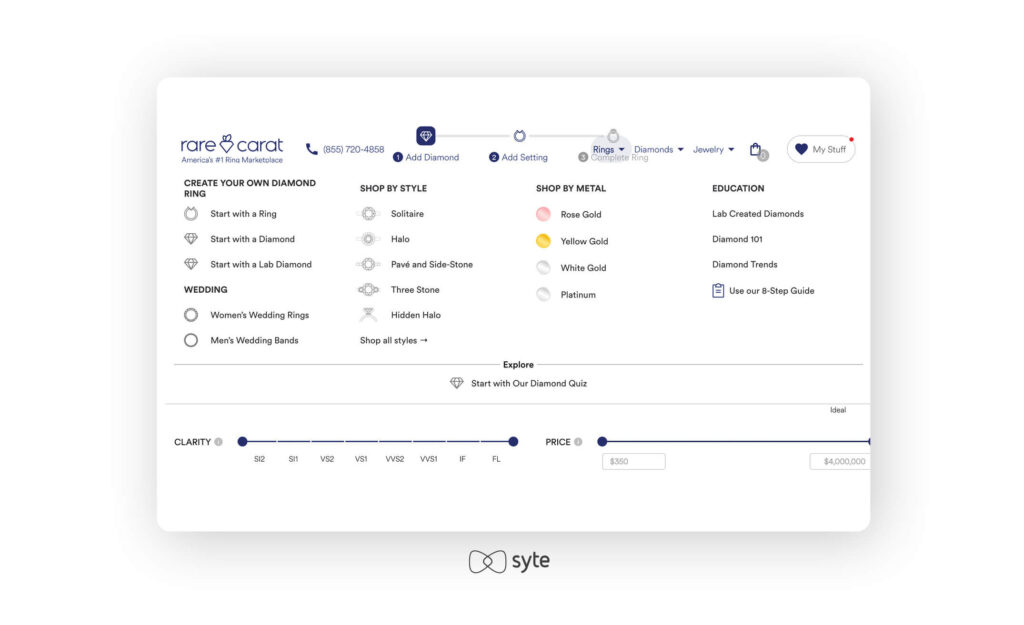
Product Listing Page Filters
Product filters help customers narrow down their search until they find the right products. Interestingly, Baymard Institute found that only 16% of brand websites provide a good filtering experience, which entails a comprehensive range of filters, a well-balanced layout, and criteria that correspond adequately with users’ expectations.
Merchandising automation software can optimize your filtering system by using accurate, structured, up-to-date, and automatic jewelry product tags. You can also add dynamic filters specific to certain categories that adjust in real time according to customer behavior. Over time, jewelry tagging can provide insights to improve your filters by identifying which attributes matter the most to customers.
Ernest Jones allows shoppers to find the perfect watch using filters such as features, movement, and strap material, while also offering general filters such as price and occasion.
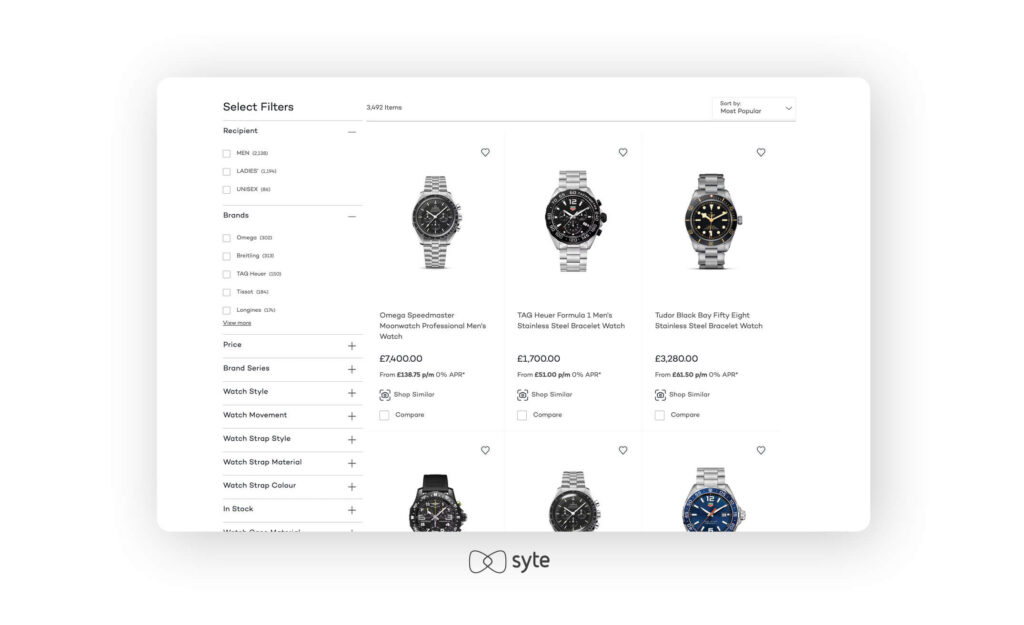
Promotions and discounts are valuable tools when users are on the fence about purchasing, nudging nearly two-thirds to close the deal.
Merchandising automation enhances the effectiveness of promotions through the strategic placement of sale SKUs and exclusive offers. This can be achieved through ranking strategies that priortize sale items or products under a certain price. During events, retailers can prominently display promos on different parts of the website, such as the homepage, search result pages, and category pages using jewelry AI.
For the occasion of Mother’s Day, Helzberg Diamonds featured an attention-grabbing banner that led to a special landing page for their sale. The products labeled with “sale” were arranged based on popularity and determined through jewelry tagging.
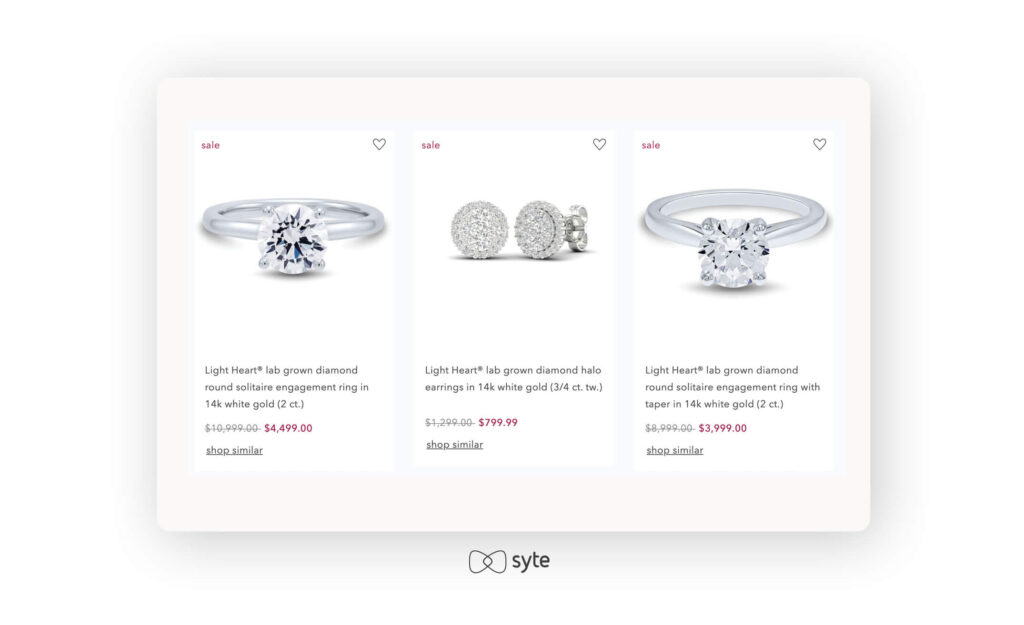
Fashion Product Tagging and Merchandising Automation Use Cases
Thematic Collections on the Homepage
Customers can land anywhere on your site, but the homepage provides the most real estate to showcase what your brand has to offer. Here, you can establish a memorable first impression and capture shoppers’ attention as well-designed storefronts do with wandering passersby on a street.
It takes online visitors only 50 milliseconds to decide whether it’s worth staying on a website, so make it worthwhile from the get-go. By using visual AI, a homepage can display dynamic collections grouped according to attributes, and collections can be based on prices, seasons, and promotions.
User-Generated Content
According to the 2021 Edelman Trust Barometer, 66% of customers now consider it more important to trust the brand they buy from than in the past. About 70% also say they desire authenticity from companies because it gives them a stronger feeling of confidence.
Social proof, when promoted together with your products, can improve your image because other customers are willing to vouch for you and what you’re selling. This can come in the form of reviews with customer photos or social media posts. Reading online reviews has been the norm in online shopping for close to half of U.S. consumers. With user-generated content (UGC) right on your website, you can fast-track shoppers’ research process.
For La Redoute, written customer reviews included on product detail pages are one UGC facet. There’s also a dedicated section on the same page populated with photos shared by members of the La Redoute community and tagged with all products they’re wearing from the retailer.
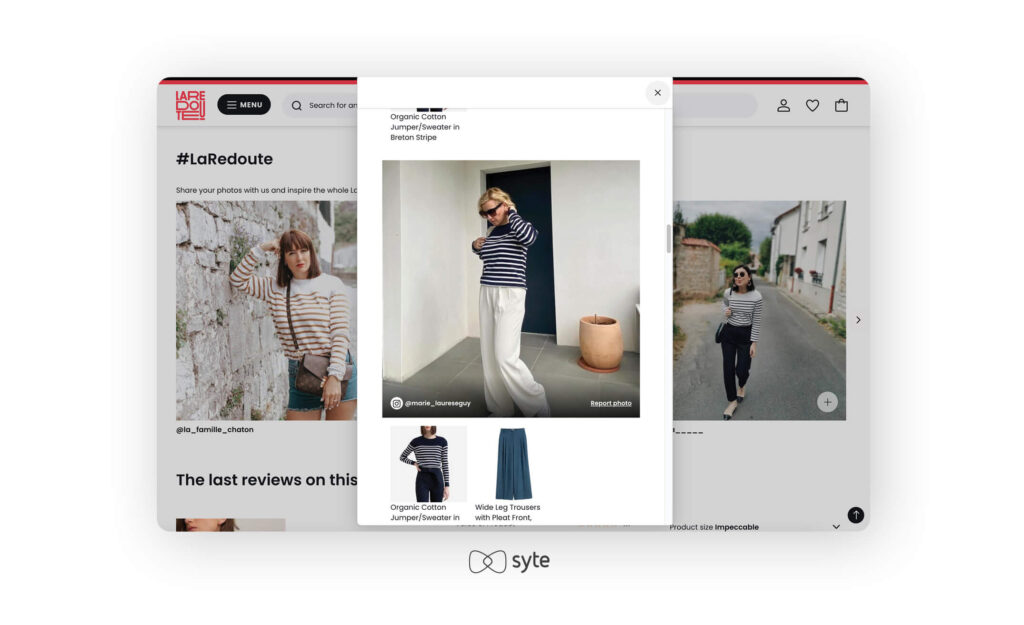
Personalized Emails
The shopping journey doesn’t have to end when a customer leaves your site. There are multiple ways to keep shoppers thinking about your brand, including emails, SMS, and push notifications. According to SaleCycle, 59% of shoppers say marketing emails influence their purchase decisions, while half buy from marketing emails at least once per month.
Brands and retailers can level up their email game with visual AI and merchandising automation. Take Browns Fashion, for instance, which uses dynamic content as part of its email campaigns. Using visual AI, emails are populated with relevant product recommendations based on items shoppers have interacted with on-site in the past. Promoting what customers have in their wishlists or abandoned carts is also a common and effective email personalization strategy.
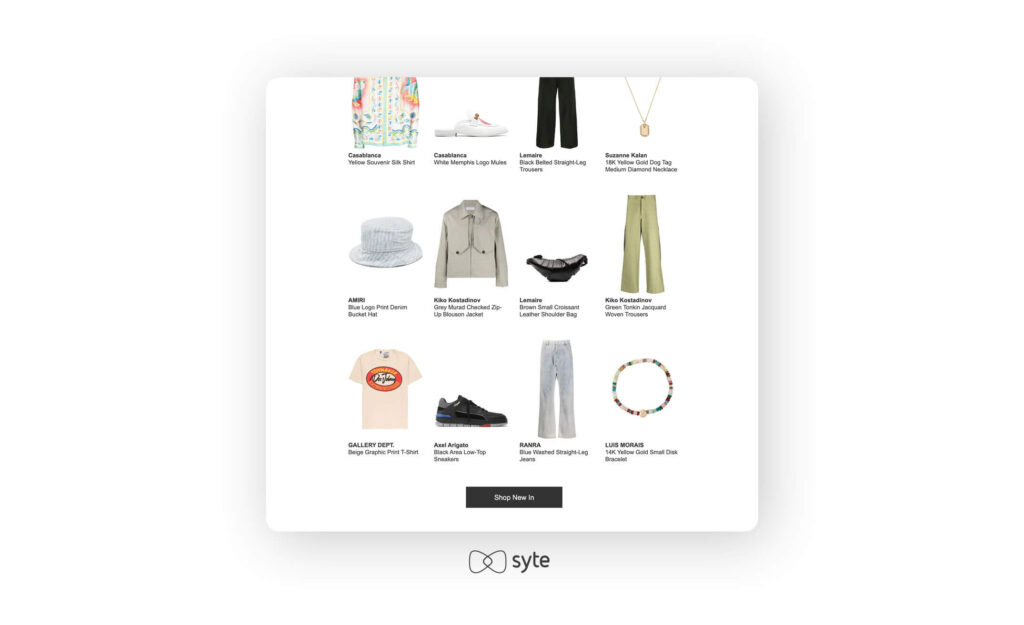
Merchandising Automation in Numbers
Brands like Perry Ellis, Nourison, and Chow Sang Sang are using Syte as part of their online visual merchandising strategy. These companies understand that the future of retail relies on merchandising automation to optimize product discovery and recommendations, streamline operations, and improve efficiency.
Perry Ellis
The menswear brand, embodying innovation since its founding in the 1970s, was looking to create a better customer experience to build long-term affinity and loyalty. Perry Ellis turned to AI for help with delivering smooth product discovery experiences. Using features such as the Discovery Button on its product detail pages and product listing pages, the retailer was able to merchandise similar products to shoppers with an affinity for particular styles and patterns.
Nourison
The B2B home decor company Nourison, a leading multi-category resource in today’s floor-covering market, sought to improve its customer experience and retention. By using visual AI, Nourison was able to enhance its on-site search and offer new ways for consumers to discover products. Image Search was particularly helpful for customers who didn’t have industry-specific knowledge, while the Discovery Button made it easy to view similar-looking merchandise with just one click.
Chow Sang Sang
Chow Sang Sang has a massive community of jewelry buyers in Asia. With a growing inventory of products, the retailer needed an efficient way to match shoppers with the perfect pieces. Visual AI proved to be the solution that Chow Sang Sang was looking for, as it could instantly extract attributes from images and provide matching results from a vast catalogue. The technology also enabled merchandising automation capabilities that powered recommendation carousels, showing customers the best items based on their preferences.
Level Up With Merchandising Automation
Merchandising automation helps brands meet customers the moment inspiration strikes, surfacing relevant results that increase the likelihood of making it to the checkout page and completing their purchase.
It also works behind the scenes to automate product tagging and merchandising rules. By leveraging automated merchandising, brands and retailers can expect long-term growth fueled by increased revenue and the loyalty of online customers who know they can count on a solid shopping experience.